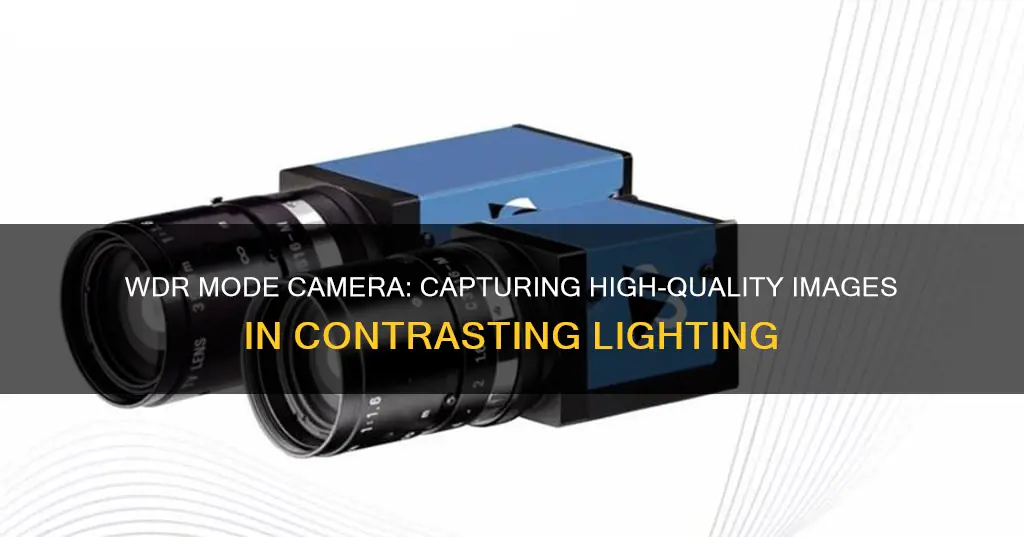
WDR stands for Wide Dynamic Range, a technology that improves the quality of video footage by enhancing the performance of CCTV cameras. WDR technology is particularly useful in security cameras as it helps to manage extremes of the light spectrum, ensuring that dark spots and glare are no longer a problem. This technology is especially beneficial when monitoring large spaces, as it enables the camera to capture and display a wider range of brightness levels in a single image, providing a clearer and more uniform image.
| Characteristics | Values |
|---|---|
| Full Form | Wide Dynamic Range |
| Purpose | Compensates for problems with exposure to light |
| Function | Captures multiple images at different shutter speeds and combines them into a single image |
| Result | Achieves a balance between brightness and darkness, improving image quality |
| Use Cases | Indoor/outdoor surveillance, security cameras, CCTV cameras |
| Types | True WDR, Digital WDR (DWDR), Forensic WDR |
| Comparison with HDR | WDR designed for surveillance in extreme lighting variations, HDR for visual aesthetics |
| Performance Impact | May introduce processing delay or affect camera performance |
| Power Consumption | May consume more power |
| Cost | WDR-capable cameras may be more expensive |
What You'll Learn

True WDR vs Digital WDR
Wide Dynamic Range (WDR) is a technology used in security cameras to compensate for exposure to light. It helps to balance out dark and bright areas in images, improving overall image quality and uniformity. This is particularly useful when monitoring areas with a mix of lighting conditions, such as entrance doors or windows, or when there are reflections or strong backlighting that would otherwise result in a loss of detail.
There are two main types of WDR: True WDR and Digital WDR (DWDR). True WDR uses both hardware and software to enhance images, while Digital WDR relies solely on software.
True WDR employs image sensors and a digital signal processor (DSP) to provide even illumination across an image. It does this by capturing two images with different light exposures and merging them into a third, optimally illuminated image. This process occurs at 60 frames per second and requires greater image processing capacity, making True WDR cameras more expensive than their Digital WDR counterparts. However, the additional investment delivers better results, producing images with an extremely wide dynamic range.
Digital WDR, on the other hand, uses algorithms instead of sensors to brighten dark areas and dim bright areas. It relies on the DSP chip and adjusts each individual pixel of the image to calculate exposure. While this technique can result in a grainier image due to the intense manipulation of pixels, it is a more economical option as it does not require costly image sensors.
The quality of WDR, whether True or Digital, is measured by a dB rating. A higher dB rating indicates superior image quality, particularly in low-light conditions, as it represents a greater scale of brightness that the camera can capture.
OSD Mode: Enhancing Your Camera's Performance
You may want to see also

How WDR improves image quality
WDR stands for Wide Dynamic Range. It is a technology used in video cameras to compensate for problems with exposure to light. WDR improves image quality by achieving a balance between brightness and darkness, resulting in a more uniform image.
Here's how it works: WDR technology uses different shutter speeds to allow more light in some areas of the image and less light in others. In brighter areas, a higher shutter speed is used so that the sensor is exposed to light for a shorter period of time. Conversely, in darker areas, a slower shutter speed is employed, allowing the sensor to capture more light over a longer duration. Both images are then combined to create a final image with intermediate lighting.
The advantage of WDR is evident when a camera is directed towards a window, where there are areas with varying levels of light. Without WDR, the image will have very dark and very bright areas, resulting in a loss of detail. However, with WDR technology, a balance is achieved, and the entire area is displayed with a uniform light level, preserving all the details.
WDR is particularly useful in scenarios where the camera is positioned inside a building and directed towards the outside, such as monitoring driveways, patios, or streets. These locations often have areas with low light, frequent light changes due to the movement of the sun, and reflections that impede uniform illumination. WDR cameras are also ideal when the camera needs to see through glass doors or windows, as they can handle the challenges posed by reflections and varying light conditions.
WDR technology comes in two main types: True WDR and WDR Digital (DWDR). True WDR cameras use different shutter speeds to capture two images with different light exposures, which are then merged to create a third image with optimal illumination. This process results in superior image quality but is more expensive and data-intensive. On the other hand, WDR Digital cameras use software compensation techniques, similar to the HDR technology in smartphones, to digitally enhance the image.
Charging Your Kodak Camera Battery: How Long Does It Take?
You may want to see also

When to use WDR
WDR stands for Wide Dynamic Range. It is a technology that helps cameras adjust their images when they contain both brightly lit and dark areas.
WDR is particularly useful in the following scenarios:
High-Contrast Environments
WDR is ideal for environments with both intense brightness and deep shadows. It helps maintain visibility in both extremes, ensuring that details in well-lit and poorly lit areas are captured. This is especially useful when there are specific security concerns in areas with challenging lighting conditions, such as entrances with strong backlighting.
Outdoor Surveillance
Outdoor lighting conditions can vary significantly throughout the day. WDR can be beneficial in handling these changing lighting conditions, ensuring that important details are not lost due to overexposure or underexposure.
Indoor Surveillance with Challenging Lighting
While indoor environments typically have more controlled and consistent lighting, there may be specific areas with challenging lighting conditions, such as rooms with large windows or glass doors, where WDR can be advantageous.
Surveillance in Low-Light Conditions
WDR technology can also enhance images in low-light conditions. Some WDR cameras are designed to be effective in these scenarios, allowing them to gather more data when faced with direct light, glare, or dark environments.
When High-Quality Monitoring is Required
WDR cameras are ideal when very high-quality monitoring is necessary. For example, when a camera is monitoring from inside a building towards the outside, there may be areas with low light, light changes due to the movement of the sun, or reflections that affect the image quality.
In summary, WDR is a valuable feature to have in security cameras to handle challenging lighting conditions and ensure that critical details are captured, regardless of whether the environment is indoors or outdoors.
Troubleshooting Camera Battery Exhaustion Issues
You may want to see also

How to adjust WDR settings
WDR, or Wide Dynamic Range, is a technology that adjusts a camera's image to improve visibility in both bright and dark areas. This is particularly useful when the lighting in a camera's field of view is uneven, and there are areas that are either too dark or too bright.
WDR works by capturing multiple images at different shutter speeds, which capture varying amounts of light. These images are then combined into a single image, resulting in a clearer picture.
To adjust the WDR settings on your camera, follow these steps:
Step 1: Access the Camera Settings
This can be done either through the server software or directly in the camera's user interface (UI).
For IP cameras, access the login page from your web browser.
Step 2: Navigate to the WDR Settings
The specific path to the WDR settings may vary depending on the camera model and software. However, they are generally found within the Image Settings or Exposure Settings.
For example, in the ProConnect software, go to "Setup > Cameras > respective camera > Image Settings tab".
Step 3: Adjust the WDR Mode and Strength
WDR typically offers three modes: On, Off, and Auto.
- The "On" mode enables WDR for all captures.
- The "Off" mode disables WDR, which may be preferable if you are looking for more colour in your images.
- The Auto" mode allows the camera to turn WDR on and off as needed, which is useful when lighting conditions vary throughout the day.
You can also adjust the strength of the WDR effect. A higher value will result in less contrast between the dark and light areas, while a lower value will preserve more contrast. It is recommended to adjust this setting sparingly, as higher WDR values can lead to lower-quality footage.
Additionally, some cameras offer a WDR Level setting, where you can specify a value from 0 to 10 to fine-tune the amount of WDR adjustment applied to the image.
Step 4: Consider Lighting and Display
While WDR can help improve exposure, proper lighting is still important to ensure optimal image quality. The more uniform the lighting is in the camera's view, the less need there is for WDR.
Additionally, consider the display or screen you are using to view the footage. Even with a high-quality camera, a low-quality display may not showcase the full capabilities of the WDR technology. Set the screen to maximum contrast if possible, as the video display will benefit from a better contrast ratio.
Salvaging Your Camera After a Battery Leak
You may want to see also

WDR and power consumption
WDR, or Wide Dynamic Range, is a technology that compensates for exposure to light in images, creating a balance between brightness and darkness. This results in sharper, more uniform images with improved overall quality. WDR technology is particularly useful in security and surveillance cameras, where lighting conditions can vary significantly and maintaining visibility in both bright and dark areas is essential.
WDR cameras achieve this balance by using different shutter speeds to control the amount of light that the sensor is exposed to. In lighter areas, a higher shutter speed is used so that the sensor is exposed to light for a shorter duration, while in darker areas, a slower shutter speed allows the sensor to capture more light over a longer period. Both images are then combined to create a final image with intermediate lighting. This process is often referred to as double exposure.
True WDR cameras capture two images with different light exposures and merge them into a third image, optimising overall illumination. These cameras capture 60 frames per second and require greater image processing capacity, resulting in higher costs. On the other hand, WDR Digital (DWDR) cameras use software compensation techniques, digitally retouching a single image. While DWDR cameras are more affordable, True WDR cameras generally produce superior results.
When deciding whether to enable WDR on a CCTV camera, it is essential to consider the specific lighting conditions and security requirements of the environment. WDR may introduce processing delays and increase power consumption, so it should only be used when necessary. In outdoor surveillance, for example, WDR can be beneficial to handle changing natural light conditions throughout the day. However, indoor environments with controlled and consistent lighting may not always require WDR.
Additionally, power efficiency should be taken into account. WDR may consume more power, so if optimising power usage is a priority, carefully evaluate whether the benefits of WDR are essential for the specific surveillance scenario.
Vive Cameras: Battery or Plug-in Power?
You may want to see also
Frequently asked questions
WDR stands for Wide Dynamic Range. It is a technology that adjusts a camera's image when it contains both brightly lit and dark areas.
WDR mode works by capturing multiple images at different shutter speeds (both slow and fast). The slow speed captures more light, while the fast speed captures less. The images are then combined to create a single image, brightening dark spots and darkening light spots to improve overall clarity.
WDR mode is useful when you want to record information in both the shadows and highlights of your image. It is particularly beneficial in high-contrast environments, such as outdoor surveillance where lighting conditions vary throughout the day, or when there are specific security concerns in areas with challenging lighting conditions.







